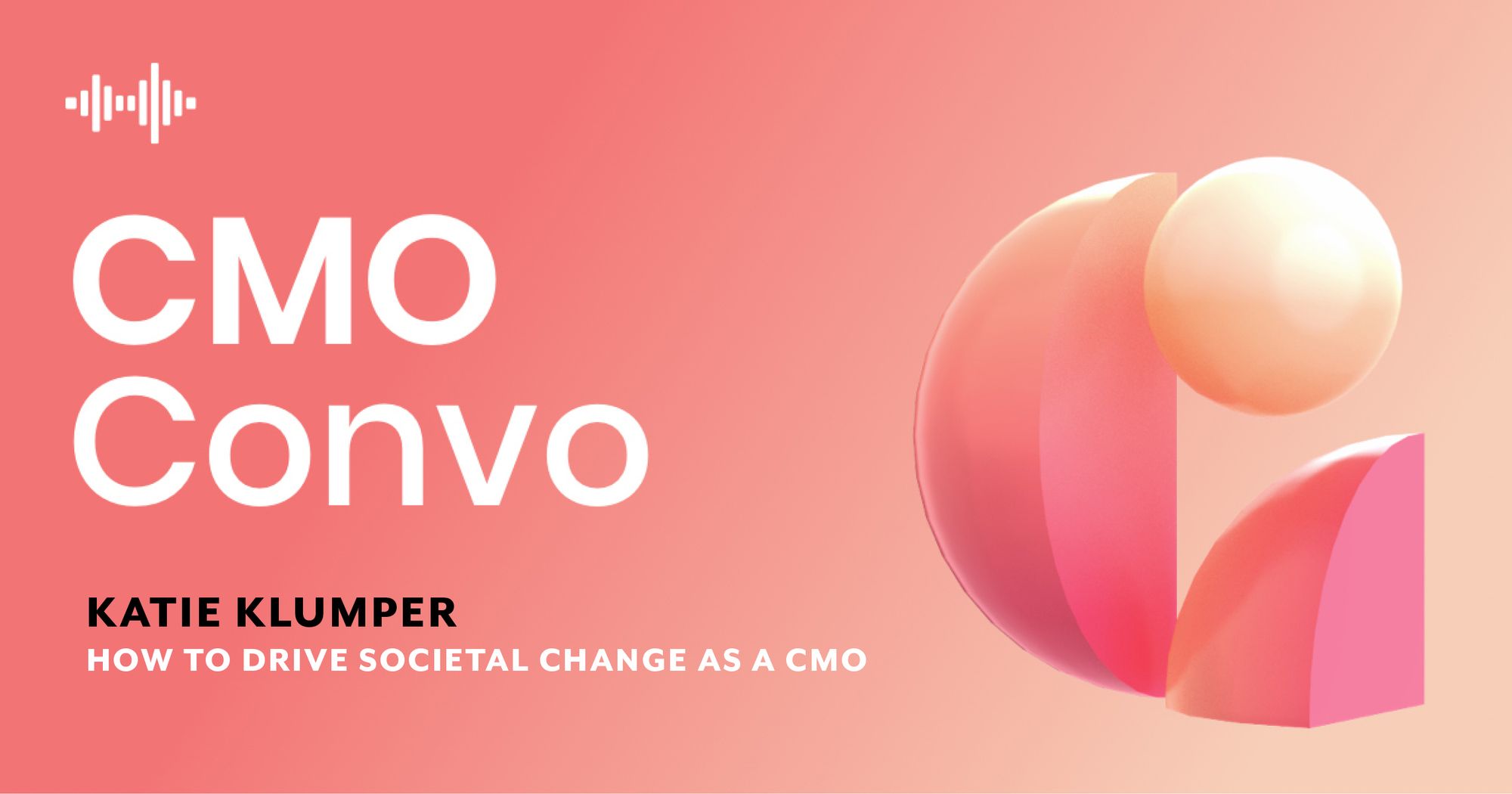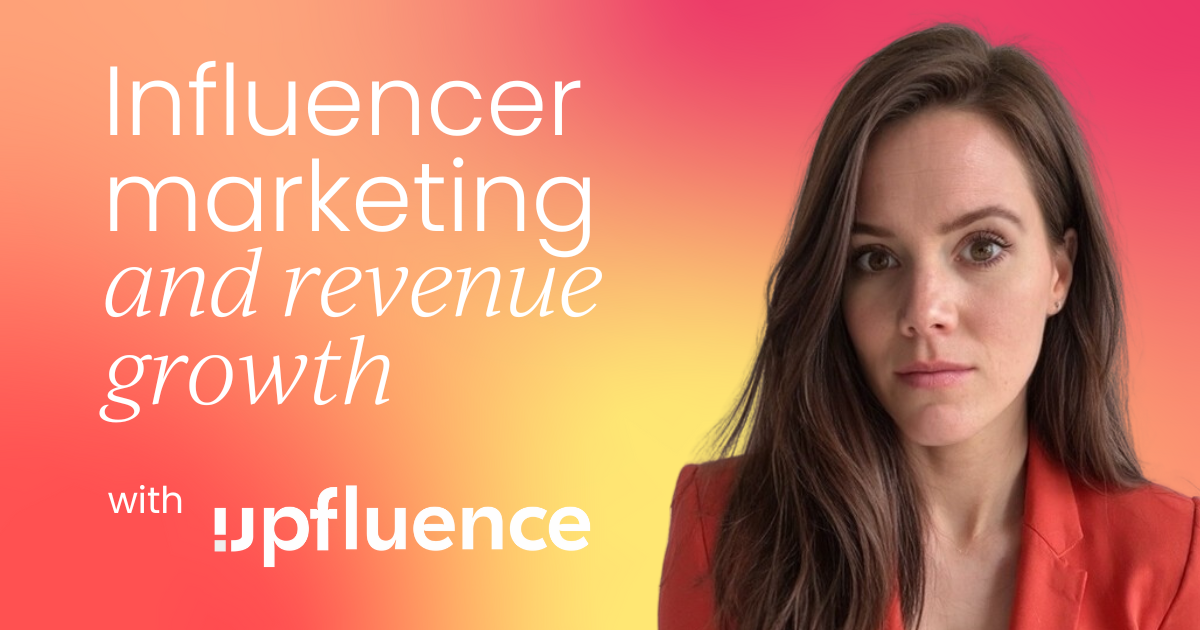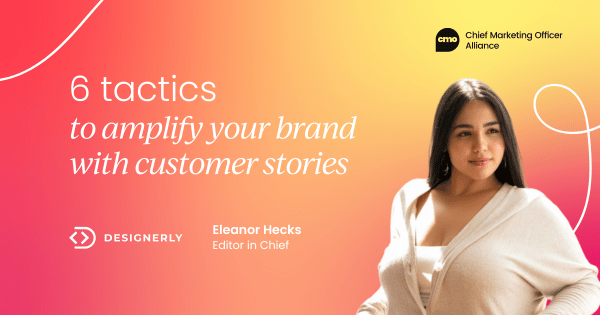It's pretty rare to be in an organization without plenty of competition. Even if you're in an apparent monopoly, the huge range of channels out there means it can be tough to know what to focus on to be the most effective. Basically, in the modern world, it can be tough to cut through clutter with marketing.
Ken Ungar, president and founder of sponsorship consulting firm Charge, is a firm advocate for utilizing sponsorship as a means to reach your audience. He joined us on CMO Convo recently to share his advice for CMOs on how to approach sponsorship, whether it's finding the right things to sponsor, to getting key stakeholders onside, and much more.
Read on for a write up for what we discussed!
- Ken's background and mission
- The problem of cluttered marketplaces
- Finding the right sponsorships as a CMO
- Sponsoring the right causes
- Showing the value of sponsorships to key stakeholders
- Measuring the success of marketing sponsorships
- Getting started with sponsorships
- The big success stories of sponsorships
- Further resources
Prefer to listen? Check out Ken's appearance on the CMO Convo podcast 👇
Ken's background and mission
Welcome to CMO Convo, Ken!
It's great to have you here because we're exploring something that's very important: clearing away the clutter of the marketplace so you can reach your audiences. But before we do get into that, maybe you’d like to introduce yourself to our audience? Tell us a bit about your professional background and your mission.
Sure. My name is Ken Ungar, and I'm the president and founder of Charge. We're a sponsorship marketing consulting firm. We're based in Indianapolis, Indiana, in the US, but we have clients all over North America. I came to marketing by a very circular path. I started my career as an attorney.
From there, I was in government service for four years. Through that process, I learned about the art of persuasion. I have a degree in both political science and business administration from university, but I went from law to government.
I was lucky enough to stumble into sports marketing. Relatively early in my career, I joined the staff of the Indianapolis Motor Speedway at IndyCar. It was here that I really fell in love with marketing. I fell in love with everything about it: what it stands for, what it does for consumers and what it means for companies.
In the process of working with those organizations, I became the CMO at IndyCar. That really solidified my love affair with marketing. I've been in marketing ever since. I founded this agency 16 years ago. Our mission is to help clients understand and leverage the power of sponsorship.
The problem of cluttered marketplaces
We're gonna assume that the way we're cutting through the clutter is through sponsorship?
I certainly am a true believer that sponsorship is a clutter cutter. I'm happy to share with you and your audience specific ways that this happens. I really sympathize with the challenge that every CMO faces in taking their message and cutting through a horribly cluttered marketplace.
Regardless of what type of industry you're in, whether it’s B2B and B2C, marketplaces are getting busier and busier. That's a good thing and a bad thing. More competition is good, it drives creativity when it comes to marketing.
But even if you're a market leader, all these new rivals coming out the woodwork is bad for you. If you're just starting out in your startup, it's gonna be a hugely daunting task to actually make your voice heard among all the different competition. But why has this happened? Is it just because there's more opportunity for businesses out there? Is it more verticals appearing out of the woodwork?
That's a great question. I think it's all of the above. When I traced my career back, I remember marketing in the pre-internet era, the dark ages! Although we thought that the marketplace was cluttered, in terms of your television, advertising, radio, it really wasn't.
I saw an infographic recently that really spoke to this issue. It talked about the 120 different marketing platforms. When I was in business school, I can assure you there were not 120 marketing platforms. And all of those platforms are firing on all cylinders, so to speak.
You have a lot of messages out there. When you think about it altogether, there are very few opportunities to shrink verticals. Verticals are created every day, especially with technology, there are more and more marketing platforms all the time. You just have this amorphous blob of messages that are bombarding consumers on a daily basis.
And because of the increase in channels, it's hard to tell where you should be looking to reach your audience as well. Your audience can be spread all over the place, especially now that social media channels are diversifying all the time.
It used to be just Facebook, Twitter, Instagram (and that's a maybe if you're in B2B). But now there's Tik Tok. People aren't using Facebook as much anymore. People are dropping off other channels, like Twitter. It's hard to even know where to find your audience. That's gotta be part of the clutter, deciding exactly where you're going to look for them.
I think the challenge for CMOs is keeping their finger on the pulse. They have to keep track of new platforms popping up. I think Tik Tok is a great example of that. You have to pay attention when others are sunsetting in popularity. No one talks about MySpace anymore, for example. The pace of change with platforms tracks technology.
We see exponential changes in technology constantly. We see new SaaS companies every day, many of which are related to marketing. The CMO is challenged with keeping their finger on the pulse of what's happening, what's fading, what works, and what's effective.
That's got to be particularly difficult in smaller organizations, where CMOs are so pressured to meet growth goals and revenue goals. They don't really have time to be going out there exploring different channels. They don't really have time to properly identify the exact channels that they need to be using to reach consumers.
They've got to stick to the tried and tested methods. They're not able to explore new opportunities, and that's gonna have a major impact on not just the marketing for an organization, but for the marketing industry as a whole. We're not able to experiment as much anymore, because we've got to be hitting those demand goals constantly.
You raise a really pivotal issue. One of my focuses is to urge CMO clients to carve out time to experiment. There has to be fearlessness towards experimentation. Success is one win out of 99 losses, right?
If you don't take the time to experiment, you're not finding the next Tik Tok. You're not really focusing on what works for your products and services and connecting with your consumers. That’s part and parcel of the process, I think.

Finding the right sponsorships as a CMO
Totally. But today, we're not going to do the experiments for the CMOs, but we're going to direct them towards avenues to explore?
Yeah, absolutely. For example, with sponsorship, the power of it is third-party validation. A sponsorship is a relationship between a property and a brand. That property could be a sports team like Manchester United or Man City.
It could be a non-profit, it could be a concert venue, whatever it is, the power of sponsorship is that you have a property validating how good the brand is. That image transfer benefits both the brands and the products and services that it sells. It can be a really, really powerful clutter cutter. And that's one of the things that we coach CMOs in how to best leverage.
Surely one of the main things is identifying the right organization to sponsor the right people. You don't want to be sponsoring someone who your audience isn't going to be paying attention to.
If your sponsor doesn’t resonate with your audience, that's gonna be a major issue. Is that something you coach? Do you coach CMOs to identify the right sponsorships?
That's exactly right. And it starts with your audience. It starts with your customer base. The better you know your customers, the more likely you are to engage in a productive sponsorship. And then you have to know the property’s audience. What you're doing is you're looking at it from a Venn diagram perspective.
You’re looking for the overlap between your customers and the property. Those are the best sponsorships. The worst ones are when your customers, from a demographic perspective, have no interest in the property that you're sponsoring.
Those are unproductive, they're a waste of money and time. Many times CMOs blame the sponsorship platform, but it’s often a mismatch with your audience. That's what happens in those circumstances.
Is there a step-by-step process that you'd advise taking to identify the right sponsorship opportunities? Is there a kind of vetting process that you go through? Because it's not just about whether they are right now, you've got to be thinking about whether they’re right in the future.
Is it worth getting into a long-term contract with these people? Is this audience going to remain consistent all the way through? Is there going to be any trouble on the horizon in terms of that company, particularly with sports teams? Sports teams are an interesting one to look at, in particular.
You've got to think about their prospects in the future. You don't want to be sponsoring a team that isn't going to win any championships in the future. Do CMOs have to take that onboard?
Yeah, exactly. The process starts with your consumer base. What are their interests? What are their values? What are their hobbies? If you understand your consumers and prospective consumers on a granular basis, that has all the breadcrumbs of where you need to go from a sponsorship perspective. You just have to follow the breadcrumbs to the right property.
The next part of that process is really where the CMO gets to pull different levers on choosing what we call ‘the tiers of cultural influence.’ In what areas do they think that they would have the most productive marketing strategy? Is it in Sports? Is it in fashion? Is it in lifestyle?
Within that, there is a matchmaking process of matching properties in those tiers to the interest of your customers, and their values. That multi-step process is the sponsorship process. Of course, if it’s a sports team, a winning team is always going to give you more benefit than one that doesn't.
Sponsoring the right causes
Definitely. Let's focus on one word that you mentioned: ‘values.’ Brand values have become even more important than ever in the last few years, particularly amongst younger audiences.
Having shared brand values is very important for Generation-Z in terms of the brands they support, whether that’s related to sustainability, whether it’s certain political movements, etc. Is sponsorship a way to ‘walk the walk’ in that respect?
Yeah, that's a great point. I really like the perspective that brands have values, because the brand really is who you are and what you stand for. If you stand for the things that you mentioned– sustainability, social justice, for example– your consumers are going to want to know that.
The survey data that we're seeing suggests that consumers align with brands that share their values. There's this area in sponsorship that's become incredibly productive called ‘purpose-driven sponsorship.’ It’s this mutual alignment between brands and NGOs ( non-profit organizations) that share their values.
It used to be called ‘corporate social responsibility.’ It got a lot of lip service 10 years ago, but now I think consumers have made brands accountable. You’re seeing these alignments in terms of sponsorship, and again, I think the power of it is third-party validation.
By having that alignment with an NGO, it’s a good seal of approval for prospective customers. People think that organization must be good because they’re aligned with a cause that they believe in.
Yeah, and you can’t just get away with changing your logo to the pride colors during pride month or doing a couple of posts during black history month. You need to show that you are actively supporting these types of organizations if that's what your brand's values are aligned with.
Sponsorship could be a very good route to go in that respect. This all makes sense from a branding perspective. But CMOs don't have the luxury of going off and doing whatever they want with the brands and the resources they have, they have to show the value behind doing these kinds of things.

Showing the value of sponsorships to key stakeholders
How can a CMO show the value of sponsorships to their CEO who has demands on their revenue streams that they've got to provide? How can we show that the sponsorship is a potential revenue stream?
Yeah, I think that's a great issue. My advice on the sponsorship front is exactly the same as I give to my CMO clients. The strongest way to show value is through a set of returns on investment metrics that are mutually agreed upon. That last part really gets lost in the corporate clutter.
The CMO coming into that position often thinks that they’re going to set the metrics, specifically success metrics and marketing. That's a mistake. The CEO might be an engineer, the CRO might be an accountant. The CFO might come from the Financial Services. None of them are marketers. Nevertheless, the metrics for success should be a collaborative effort.
There needs to be a process internally where those success metrics are mutually agreed upon. That way, there are no inbound bullets shooting towards the CMO, because those metrics were mutually agreed upon. When they occur or don't occur, there's a shared feeling of success, or shared incentive to improve.
Yeah and not just making sure they're mutually agreed upon, but making sure they're mutually understood. You can't just use marketing jargon and buzzwords as your KPIs. They have to be something that someone who has no marketing background can understand within the C-suite. You've got to be able to communicate the value in terms that they understand clearly.
That’s a great point! In the course of my career, and in the work that our consulting firm does, we’ve seen a high number of engineers, and doctors in the medical field. You often have executive directors and chief executive officers who come from a science-related background, where things can be proven by the laws of physics.
Your point about understanding is so key because a lot of times people coming from those backgrounds don't understand why marketing can't be measured with the same degree of certainty as science.
And so that mutual understanding, taking the time to describe the challenges of marketing metrics, and ensuring understanding on both sides of it, is so crucial.
So, when it comes to setting up the sponsorship agreements, and the KPIs that we're getting there, would it be worth having other stakeholders involved in that conversation? Or should that just be a CMO having that conversation? And then they translate the terms of the agreement to the rest of the stakeholders within the C-suite?
What I recommend is having stakeholders outside the process participate. It's gonna seem like a burden. It takes a lot of patience to do that. But you're creating this process of consensus, creating marketing advocates all throughout the organization, and that cascades throughout the organization.
The benefits of that are like putting a deposit in a bank account. You are depositing all this goodwill, which you will reap down the road in good times or bad times. Marketing will get the credit for accomplishments, but in the bad times, you won't have all this inbound fire from people taking potshots at the CMO and his or her staff. Because again, everyone was part of the process.
Definitely.
Measuring the success of marketing sponsorships
So, let's talk about the ways that you can actually measure the success of a sponsorship deal. Your logo actually appearing on a screen at major sporting events has got to be a huge thing. But what are the other metrics CMOs should focus on when setting up these kinds of agreements?
We’re talking about increasing brand awareness and increasing brand consideration. We've seen companies use sponsorship to reform their brand, but how do you improve that through sponsorship? There's this whole series of metrics around brand.
Usually, it’s demonstrated by survey data. If it's an event sponsorship, you're going to be looking at survey data around the event. If it's a national or international sponsorship, you need a wider survey with a broader consumer base.
And then you have your metrics on the sales side. You have sponsorship being used to lift product and service sales directly. The idea is that the audience of the property is more inclined to perceive your message positively. That'll translate either to B2B or B2C in a lift in the sales, whether it's a product or a service.
So there are metrics around that. You see this in a lot of the beverage companies, from a consumer product perspective, with all that event sponsorship money, they are looking for a lift of cases sold tied to the sponsorship. They’re very scientific in terms of how they look at their sales lift around sponsorship.
That's the advantage with beverage companies: the events that they're sponsoring are likely to be events where people will be consuming those beverages as well.
For example, The Six Nations Rugby championship was on recently in Europe and is sponsored by Guinness in the UK. And people drank a heck of a lot of Guinness! There's a reason Budweiser always heavily attach themselves to the Super Bowl.
But B2B companies might not have those kinds of consumer metrics in place. What do they do in that instance?
Great question. With B2B sponsorships, it generally comes down to access. The sponsors have access to a property in a way that a normal company does not. A lot of times you see B2B with exclusive exposure to that audience of their product or service.
Or, if they're entertaining, they're providing this one-of-a-kind access to their potential customers. There are all kinds of data demonstrating how that speeds up the sales cycle. If you have a six-month or 12-month sales cycle, whatever B2B product or service you have, there's data that demonstrates that it shrinks because you're giving your prospects access to an event they wouldn't ordinarily have.
And your executives have access to the prospects directly, right? In your rugby example, if you're sitting around drinking Guinness with your prospects and talking shop, that’s going to reap benefits.
It must be a really good way to shrink that validation stage of the buying cycle. It’s a great way of shrinking that stage where people are considering whether you’re a trustworthy company or not.
Having your name attached to a company or an event that is considered trustworthy allows you to bask in the glow of their trustworthiness.
We recently wrote a book called Sponsorship Strategy. In that, we talked about what’s called ‘Image transfer.’ That's the superpower of sponsorship. If I feel that the property has a great image, I'm going to thank the sponsors as well. That transfer is measurable and demonstrable.
Getting started with sponsorships
Let’s say a B2B startup is thinking about exploring sponsorship. What would you advise in terms of how they go about it? Should they cast their net wide? Should they focus on building one really good partnership? What do you see as the best route?
Sponsorship is something that can get you in trouble really fast. One of the reasons is that generally the best sponsorships are not short term. We’ve seen CMOs start signing long term sponsorship agreements, and they don't work. We've seen both CMOs and CEOs lose their jobs over things like that.
We recommend this: start small, test, and experiment. Do something that aligns with your research, but start small. There are two components to a sponsorship. The first is the rights fee. So, if you sponsor a sporting team, you're going to pay them a fee to sponsor the team.
The second part is called activation.That's the money that you put into integrated marketing campaigns, around your sponsorship, social media, PR advertising, etc. You have this activation process of bringing your rights in that property to life.
The mistake that brands often make is not reserving enough budget to be able to activate properly because they've spent all the money on rights. If you sponsor a Premier League soccer team, you're gonna spend a lot of money on rights. So, you better have a lot of money. In summary: start small, experiment and test. And have enough money to activate your rights after the deal is done.
Maybe you could start by sponsoring something small within the organization and seeing what kind of benefits you get from that. And then you could look into doing bigger, more intense sponsorship partnerships?
I think one of the best examples comes from the world of motorsports. If you take Formula One, for example, you see these small decals advertised on the cars. But it's not the primary sponsorship that you see written big and bold.
These are the associate sponsors and they’re experiencing the sponsorship at a lower-risk level. It's less of a financial commitment, but often you see them grow into that primary sponsorship position once they learn that it’s a mutually beneficial partnership.
I saw this with an associate sponsor, Oracle, on the Red Bull team.They had been associate sponsors of the Red Bull f1 team, and they ended up taking the primary position within sponsorship.
The big success stories of sponsorships
Red Bull is an excellent example of as they've pretty much built their entire brand around sponsorship. Most of their advertising and marketing is built around sponsoring certain events and sports teams.
Absolutely. Red Bull is a great example of a lot of things.
For sure! However, we're going to assume you're not advising all CMOs to start sponsoring people to jump out of airplanes, right?
But that’s authentic to their brand, right? Brands are about behaviors. “Red Bull gives you wings” It’s perfect for jumping out of airplanes.
[The Red Bull Stratos jump in 2012] was such a perfect piece of marketing, and it was all based around the sponsorship. It’s a great example of how you can cut through the clutter. No one was talking about anything else on social media for days. They were talking about the Red Bull Jump. And they were calling it the Red Bull Jump as well.
A lot of CMOs look at Red Bull in case studies. They know who they are and they do it very well. They execute on extremely high level strategies well.
Further resources
Definitely. Are there examples and resources our readers can look at if they're looking to explore the possibilities of sponsorships? You mentioned you've written a book recently. Where's that available?
Our book is available around the world via Amazon. It's both paperback and Kindle. It’s available in the Apple bookstore, as well. It’s called Sponsorship Strategy. I wrote it for CMOs, because I want it to promote best practices and sponsorship across the entire marketing profession.
Other resources for CMOs are available on our website. Our goal is for people to leverage sponsorship in the way that best helps their brands, however that happens. Whether they hire us or not, we want sponsorship to flourish as a marketing platform.
Are you looking into sponsorships and don't know where to start? Have you had great success with sponsoring certain things? Join the CMO Alliance Community Slack channel!







.png)









 Follow us on LinkedIn
Follow us on LinkedIn





